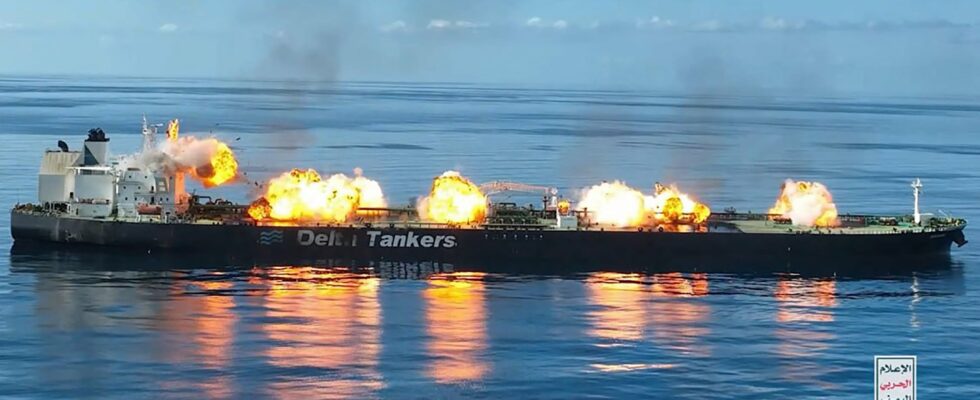For two weeks, an oil tanker loaded with a million barrels of crude has been burning on the high seas, 140 kilometers off the coast of Yemen. Bad news: it’s not about to stop. According to the European Union mission involved in this operation, the conditions are “not right” to tow this ship, attacked on August 21 by Yemeni rebels.
“The private companies responsible for the rescue operation have concluded that the conditions are not right to carry out the towing operation and that it is not safe to continue,” the EU’s Aspides mission said on its X account. One thing is certain: this attack poses an environmental risk in the Red Sea and represents an “imminent threat of regional pollution,” it warned.
The “Sounion”, which flies the Greek flag and is carrying 150,000 tonnes of crude oil, was hit by projectiles launched by the Houthis. The latter, supported by Iran, then claimed to have detonated charges on the ship, causing several fires on board, before “authorizing” its rescue. The Aspides mission, deployed in February to protect merchant shipping from attacks by these rebels, indicated on Monday, September 2, that the ship was still on fire, and that it would ensure the protection of tugboats “to prevent an environmental catastrophe” in the Red Sea. The American military command for the Middle East (Centcom) indicated, on Monday, that the rescue operation was underway.
“A potential environmental catastrophe”
On Wednesday, September 4, aerial images of the Sounion showed several fires burning on the deck. Although there is no apparent oil leak yet, the Pentagon expressed concerns Tuesday about a “potential environmental catastrophe.” In the event of pollution, the disaster could also set European insurance markets on fire. “All the means implemented have a cost, the consequences to be dealt with can be gigantic, and the means to deal with them seem very weak,” estimated a maritime insurance expert in the columns of Release.
The US State Department said the million-barrel oil spill would be four times larger than the Exxon Valdez disaster in Alaska in 1989. A disaster that caused a major oil spill and the death of 300,000 birds. Thus, large-scale pollution in the Red Sea could have a devastating impact on its ecosystem, especially since it is also a strategic location for the economy of the coastal countries. But the latter are poorly equipped to combat accidental pollution, with the exception of Saudi Arabia, which is reluctant to cooperate for political reasons.
According to the environmental protection agency of the internationally recognized Yemeni government based in Aden, whose data was taken from The World, 78,000 fishermen and their families, or nearly half a million people, could be affected by massive pollution.
Global shipping ‘shaken up’
“The Iran-aligned Houthis have sunk two ships and killed at least three crew members in a 10-month campaign that has disrupted global shipping by forcing shipowners to avoid the Suez Canal shortcut,” the British daily recalls. The Guardian.
In March 2024, it was the Rubymar, flying the Belize flag, hit by the Houthis, which sank with its cargo of 21,000 tons of fertilizer based on ammonium phosphate sulfate. “We call on the Houthis to immediately cease these actions and we urge other nations to intervene to help prevent this environmental catastrophe,” said, this Saturday, September 7, in a statement, the spokesperson for the US Department of State, Matthew Miller.
Since November, Yemeni rebels have been targeting ships they believe are linked to Israel, saying they are acting in solidarity with Palestinians in the region. Gaza Stripwhere a war has been going on between the Islamist movement Hamas and the Hebrew state since October 7. Their attacks have prompted the United States to set up an international maritime coalition and to strike rebel targets in Yemen, sometimes with the help of the United Kingdom. But beyond the geopolitical or strategic issues, it is the survival of biodiversity in the Red Sea that is at stake.
